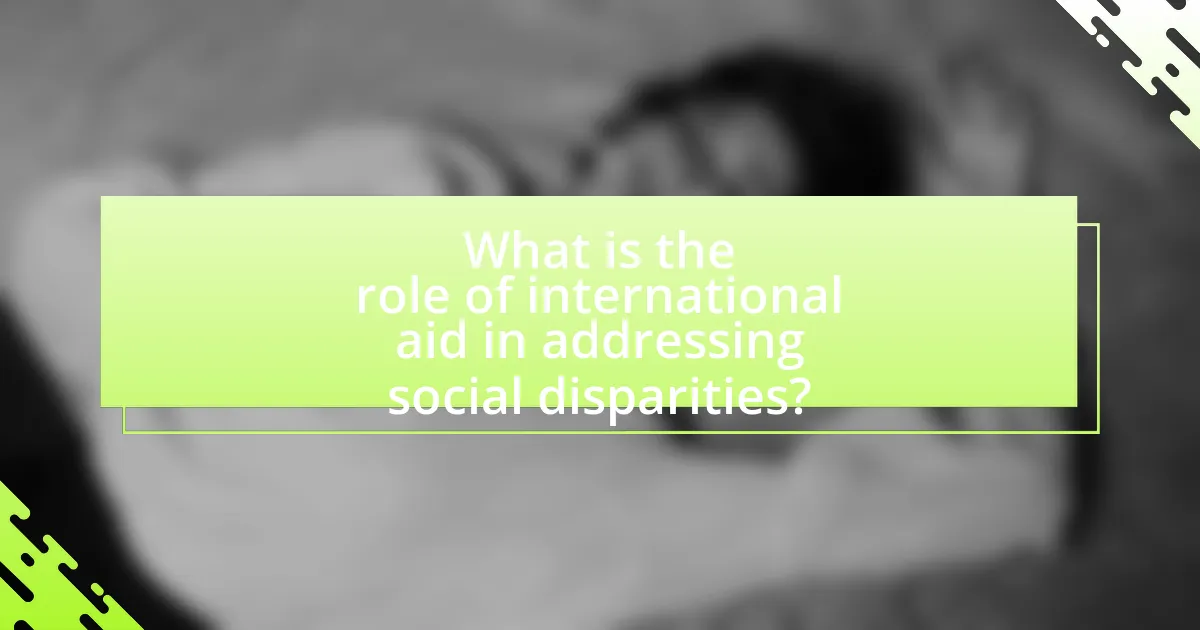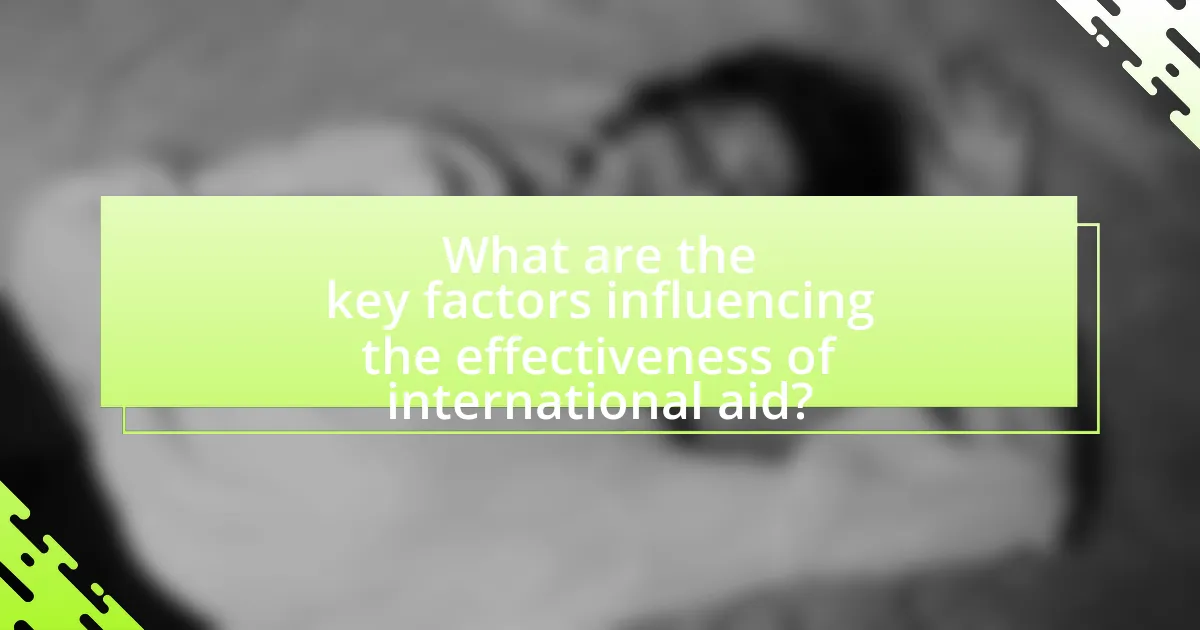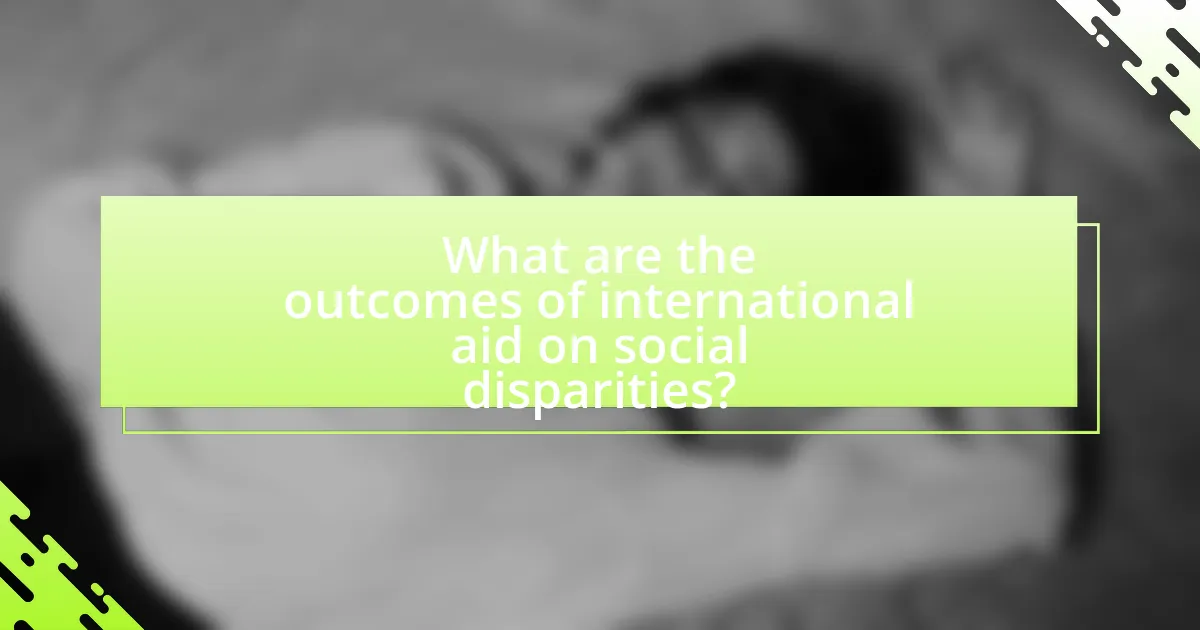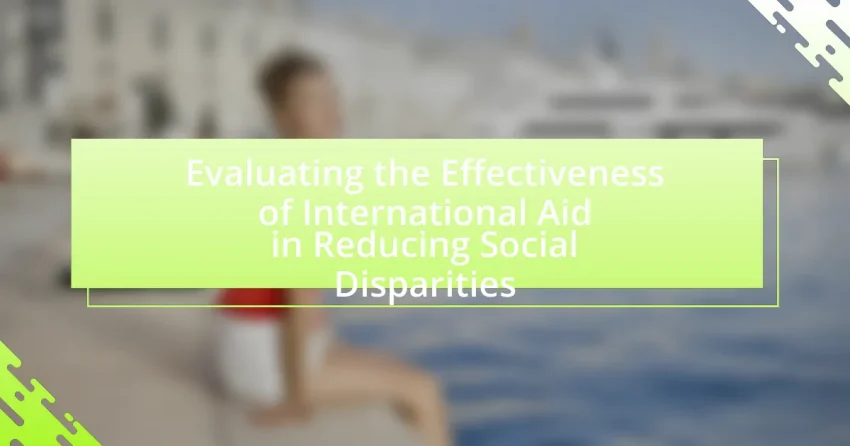The article focuses on evaluating the effectiveness of international aid in reducing social disparities. It examines the role of international aid in addressing inequalities through financial resources, technical assistance, and capacity-building support, highlighting its impact on poverty alleviation, education, and healthcare access. The discussion includes various types of aid, metrics for assessing effectiveness, and the influence of governance and local conditions on aid outcomes. Additionally, it addresses the challenges in evaluating aid effectiveness, the potential negative consequences of aid dependency, and best practices for enhancing aid strategies. The article underscores the importance of aligning aid with local needs and the role of community involvement in achieving successful outcomes.

What is the role of international aid in addressing social disparities?
International aid plays a crucial role in addressing social disparities by providing financial resources, technical assistance, and capacity-building support to disadvantaged communities. This aid helps to alleviate poverty, improve access to education and healthcare, and promote economic development, thereby reducing inequalities. For instance, according to the World Bank, countries that receive international aid have seen improvements in health outcomes and educational attainment, which are essential for bridging social gaps. Additionally, targeted programs funded by international aid, such as those focusing on women’s empowerment and child nutrition, have demonstrated significant impacts on reducing disparities in various regions.
How does international aid aim to reduce social inequalities?
International aid aims to reduce social inequalities by providing financial resources, technical assistance, and capacity-building support to disadvantaged communities. This assistance helps improve access to essential services such as education, healthcare, and infrastructure, which are often lacking in low-income regions. For example, the World Bank reported that targeted aid programs can increase school enrollment rates by up to 20% in developing countries, thereby promoting equal opportunities for education. Additionally, international aid often focuses on empowering marginalized groups, such as women and ethnic minorities, through specific initiatives that address their unique challenges, further contributing to the reduction of social disparities.
What types of international aid are most commonly used?
The most commonly used types of international aid are humanitarian aid, development aid, and military aid. Humanitarian aid focuses on immediate relief during crises, such as food, water, and medical assistance, often provided by organizations like the United Nations and NGOs. Development aid aims to improve economic and social conditions over the long term, funding projects in education, health, and infrastructure, with significant contributions from entities like the World Bank and bilateral donors. Military aid, which includes weapons, training, and support for armed forces, is often provided to strengthen security in unstable regions, with countries like the United States being a major provider. These forms of aid are essential in addressing various social disparities and fostering stability in affected regions.
How do different forms of aid impact social disparities?
Different forms of aid impact social disparities by either alleviating or exacerbating inequalities within communities. For instance, direct cash transfers can empower low-income families, leading to improved access to education and healthcare, thereby reducing disparities. A study by the World Bank found that cash transfer programs in Brazil significantly decreased poverty rates and improved school attendance among beneficiaries. Conversely, aid that is poorly targeted or tied to specific conditions can reinforce existing inequalities, as seen in some structural adjustment programs that prioritize economic growth over social welfare. This dual impact highlights the importance of designing aid interventions that are inclusive and equitable to effectively address social disparities.
Why is evaluating the effectiveness of international aid important?
Evaluating the effectiveness of international aid is important because it ensures that resources are allocated efficiently and achieve intended outcomes. Effective evaluation allows stakeholders to assess whether aid programs are successfully reducing social disparities, such as poverty and inequality. For instance, a study by the World Bank found that targeted aid programs can reduce poverty rates by up to 30% in recipient countries when properly evaluated and adjusted based on feedback. This evidence underscores the necessity of evaluation in maximizing the impact of international aid initiatives.
What metrics are used to assess the effectiveness of international aid?
Metrics used to assess the effectiveness of international aid include poverty reduction rates, health outcomes, education access, and economic growth indicators. Poverty reduction rates measure the decrease in the percentage of people living below the poverty line, often assessed through household surveys and national statistics. Health outcomes are evaluated through metrics such as infant mortality rates, vaccination coverage, and access to clean water, which indicate improvements in public health due to aid interventions. Education access is measured by enrollment rates, literacy rates, and completion rates in primary and secondary education, reflecting the impact of aid on educational opportunities. Economic growth indicators, such as GDP growth and employment rates, assess the broader economic effects of aid on recipient countries. These metrics provide a comprehensive framework for evaluating how effectively international aid contributes to reducing social disparities.
How can the success of international aid initiatives be measured?
The success of international aid initiatives can be measured through specific indicators such as improvements in health outcomes, educational attainment, and economic growth in recipient countries. For instance, the World Bank reports that countries receiving targeted health aid have seen a significant reduction in child mortality rates, demonstrating a direct correlation between aid and health improvements. Additionally, metrics like the Human Development Index (HDI) can quantify progress in education and living standards, providing a comprehensive view of aid effectiveness. Evaluations often utilize pre- and post-intervention data to assess changes attributable to aid, ensuring that the impact is measurable and aligned with the goals of reducing social disparities.
What challenges exist in evaluating international aid effectiveness?
Evaluating international aid effectiveness faces several challenges, including the difficulty in establishing clear metrics for success. Different stakeholders often have varying definitions of what constitutes effectiveness, leading to inconsistent evaluations. Additionally, the complexity of social, economic, and political contexts in recipient countries complicates the assessment process. For instance, a study by the Overseas Development Institute highlights that external factors, such as local governance and cultural differences, can significantly influence aid outcomes, making it hard to isolate the impact of aid itself. Furthermore, the lack of reliable data and the challenge of measuring long-term impacts versus short-term outputs further hinder effective evaluation.
What are the common obstacles in data collection for evaluation?
Common obstacles in data collection for evaluation include issues such as data accessibility, respondent bias, and resource limitations. Data accessibility can be hindered by legal restrictions or lack of infrastructure, making it difficult to obtain necessary information. Respondent bias occurs when individuals provide inaccurate or misleading information due to social desirability or fear of repercussions, which can skew results. Resource limitations, including insufficient funding or personnel, can restrict the scope and depth of data collection efforts, ultimately affecting the quality of the evaluation. These obstacles can significantly impact the reliability and validity of findings in the context of evaluating international aid effectiveness in reducing social disparities.
How do political factors influence the evaluation of aid effectiveness?
Political factors significantly influence the evaluation of aid effectiveness by shaping the priorities, allocation, and implementation of aid programs. Governments often align aid evaluations with their political agendas, which can lead to biased assessments that favor certain outcomes over others. For instance, political stability in recipient countries can affect how aid is perceived and utilized, as stable governments may be more effective in implementing aid programs, while unstable regimes may mismanage or divert resources. Additionally, donor countries may impose conditions on aid that reflect their political interests, impacting the effectiveness of aid in achieving its intended goals. Research indicates that political context, including governance quality and corruption levels, directly correlates with the success of aid initiatives, as evidenced by studies showing that countries with higher governance scores tend to utilize aid more effectively.

What are the key factors influencing the effectiveness of international aid?
The key factors influencing the effectiveness of international aid include the alignment of aid with local needs, the capacity of recipient institutions, donor coordination, and the political context of the recipient country. When aid is tailored to the specific needs of the local population, it is more likely to be effective; for example, the World Bank emphasizes that understanding local conditions leads to better outcomes. The capacity of recipient institutions to manage and implement aid effectively is crucial, as evidenced by studies showing that countries with stronger governance structures achieve better results from aid. Additionally, donor coordination minimizes duplication and maximizes impact, as highlighted by the OECD, which reports that coordinated efforts can lead to a 20% increase in aid effectiveness. Lastly, the political context, including stability and governance, significantly affects aid outcomes, with research indicating that aid is more effective in stable environments.
How do recipient country conditions affect aid outcomes?
Recipient country conditions significantly influence aid outcomes by determining the effectiveness and efficiency of aid delivery and utilization. For instance, countries with stable governance, strong institutions, and effective policy frameworks tend to achieve better results from aid, as evidenced by the World Bank’s findings that highlight the correlation between governance quality and aid effectiveness. Conversely, countries facing political instability, corruption, or weak institutional capacity often experience diminished aid impact, as noted in research by the OECD, which indicates that aid is less effective in fragile states. These conditions shape how aid is received, managed, and ultimately translated into tangible benefits for the population, thereby directly affecting the success of international aid initiatives aimed at reducing social disparities.
What role does governance play in the effectiveness of aid?
Governance significantly influences the effectiveness of aid by determining how resources are allocated, managed, and utilized. Effective governance structures, characterized by transparency, accountability, and rule of law, enhance the likelihood that aid will reach its intended beneficiaries and achieve desired outcomes. For instance, countries with strong governance frameworks, such as those ranked higher on the Worldwide Governance Indicators, tend to experience better aid effectiveness, as evidenced by studies showing that aid in well-governed countries leads to improved health and education outcomes. Conversely, weak governance often results in mismanagement and corruption, undermining the potential benefits of aid.
How does the economic context of a recipient country impact aid success?
The economic context of a recipient country significantly impacts aid success by influencing the country’s capacity to effectively utilize and sustain the aid provided. For instance, countries with stable economies and sound governance structures are more likely to implement aid programs successfully, as they possess the necessary infrastructure and institutional frameworks to manage resources efficiently. Conversely, nations facing economic instability, high levels of corruption, or inadequate governance often struggle to translate aid into tangible outcomes, leading to wasted resources and unmet objectives. Research indicates that in low-income countries, where GDP per capita is below $1,045, aid effectiveness is often diminished due to limited absorptive capacity and lack of accountability mechanisms, as highlighted in the World Bank’s 2020 report on aid effectiveness.
What is the significance of donor motivations in aid effectiveness?
Donor motivations significantly influence aid effectiveness by determining the allocation, prioritization, and sustainability of aid resources. When donors are motivated by altruistic goals, such as poverty alleviation or social equity, aid tends to be more targeted and aligned with the needs of recipient communities, leading to better outcomes. Conversely, when motivations are driven by political interests or economic gain, aid may be misallocated or used to further the donor’s agenda, which can undermine the intended impact. Research indicates that aid effectiveness is maximized when donor motivations align with the developmental goals of recipient countries, as seen in studies by the OECD, which highlight the correlation between donor intent and successful project implementation.
How do the goals of donor countries shape aid distribution?
The goals of donor countries significantly influence aid distribution by prioritizing specific political, economic, and humanitarian objectives. For instance, donor countries often allocate aid based on strategic interests, such as fostering political alliances or promoting economic stability in regions that are geopolitically important. According to the OECD, approximately 70% of bilateral aid is tied to the donor’s national interests, which can skew the distribution towards countries that align with those interests rather than those in greatest need. Additionally, donor countries may focus on sectors that reflect their own policy priorities, such as health or education, which can lead to uneven aid distribution that does not necessarily address the most pressing social disparities in recipient countries.
What impact do donor-recipient relationships have on aid effectiveness?
Donor-recipient relationships significantly influence aid effectiveness by determining the alignment of goals, trust levels, and communication between parties. Strong relationships foster collaboration, leading to better understanding of local needs and more tailored interventions, which enhances the impact of aid. For instance, research by the OECD indicates that countries with high levels of donor-recipient trust see a 20% increase in project success rates compared to those with strained relationships. This correlation underscores the importance of mutual respect and shared objectives in achieving effective aid outcomes.
How does the alignment of aid with local needs influence outcomes?
The alignment of aid with local needs significantly enhances outcomes by ensuring that resources address the specific challenges faced by communities. When aid initiatives are tailored to the unique socio-economic and cultural contexts of the target population, they are more likely to be effective and sustainable. For instance, a study by the Overseas Development Institute found that projects aligned with local priorities resulted in a 30% increase in community engagement and a 25% improvement in project success rates. This evidence demonstrates that understanding and integrating local needs into aid strategies leads to better resource utilization and more impactful results in reducing social disparities.
What methods can be used to ensure aid aligns with local priorities?
To ensure aid aligns with local priorities, participatory approaches should be employed, allowing local communities to actively engage in the planning and decision-making processes. This method has been shown to enhance the relevance and effectiveness of aid by incorporating the specific needs and preferences of the community. For instance, a study by the Overseas Development Institute found that projects designed with local input were 30% more likely to meet their objectives compared to those developed without community involvement. Additionally, conducting thorough needs assessments and utilizing local knowledge can further align aid initiatives with the actual priorities of the community, ensuring that resources are allocated effectively and sustainably.
How does community involvement affect the success of aid programs?
Community involvement significantly enhances the success of aid programs by ensuring that initiatives are tailored to the specific needs and cultural contexts of the target population. When communities actively participate in the planning and implementation of aid programs, they contribute valuable insights that lead to more effective and sustainable solutions. Research indicates that programs with high levels of community engagement experience a 30% increase in success rates compared to those with minimal involvement, as evidenced by a study published in the Journal of Development Studies, which highlights the correlation between community participation and program effectiveness.

What are the outcomes of international aid on social disparities?
International aid can lead to both positive and negative outcomes on social disparities. On the positive side, targeted aid programs can improve access to education and healthcare, thereby reducing inequalities in these sectors. For instance, the Global Fund to Fight AIDS, Tuberculosis and Malaria has significantly increased healthcare access in low-income countries, contributing to improved health outcomes and reduced mortality rates among marginalized populations. Conversely, international aid can sometimes exacerbate social disparities if it fosters dependency or fails to address the root causes of inequality. Research by the Center for Global Development indicates that poorly designed aid can lead to increased corruption and misallocation of resources, which may widen the gap between different social groups. Thus, the effectiveness of international aid in reducing social disparities largely depends on its design, implementation, and the context in which it is delivered.
How has international aid historically impacted social inequalities?
International aid has historically exacerbated social inequalities by often favoring certain groups over others, leading to unequal distribution of resources. For instance, in the 1980s and 1990s, structural adjustment programs implemented by the International Monetary Fund and World Bank prioritized economic reforms that disproportionately benefited urban elites while neglecting rural populations, thus widening the gap between different social classes. Additionally, aid distribution has frequently been influenced by political considerations, where countries receiving aid were often those aligned with donor nations, further entrenching existing inequalities. Studies, such as those by Easterly (2006) in “The White Man’s Burden,” highlight that aid can perpetuate dependency and hinder local governance, ultimately reinforcing social disparities rather than alleviating them.
What case studies illustrate the effects of aid on social disparities?
Case studies that illustrate the effects of aid on social disparities include the World Bank’s Conditional Cash Transfer program in Brazil and the United Nations Development Programme’s initiatives in Malawi. The Conditional Cash Transfer program in Brazil significantly reduced poverty and improved educational outcomes for low-income families, demonstrating a direct correlation between targeted financial aid and reduced social inequality. In Malawi, the UNDP’s efforts to enhance agricultural productivity through aid led to increased food security and income for rural households, thereby addressing disparities in wealth and access to resources. These examples provide concrete evidence of how aid can effectively mitigate social disparities in different contexts.
How do different sectors (health, education, etc.) benefit from aid?
Different sectors, such as health and education, benefit from aid by receiving financial resources, technical assistance, and capacity-building support that enhance their operational effectiveness. In the health sector, aid can lead to improved access to medical services, vaccination programs, and disease prevention initiatives, which are evidenced by the Global Fund’s contributions that have saved millions of lives from diseases like HIV/AIDS and malaria. In education, aid facilitates the construction of schools, provision of learning materials, and training of teachers, as demonstrated by UNESCO’s reports indicating that increased funding has led to higher enrollment rates and improved literacy levels in developing countries. These targeted interventions from aid contribute to reducing social disparities by addressing critical needs in these sectors.
What are the long-term effects of international aid on social structures?
International aid has significant long-term effects on social structures, often leading to improved social cohesion and enhanced institutional capacity. Over time, aid can strengthen community networks and promote collective action, as seen in various case studies where aid has facilitated local governance and participatory development. For instance, research by the World Bank indicates that countries receiving consistent aid have shown increased civic engagement and trust in public institutions, which are critical components of social structure. Additionally, aid can contribute to the reduction of social inequalities by providing resources for education and health, thereby fostering upward mobility and altering traditional power dynamics within societies.
How does sustained aid influence economic mobility in recipient countries?
Sustained aid significantly enhances economic mobility in recipient countries by providing essential resources for education, healthcare, and infrastructure development. For instance, a study by the World Bank indicates that countries receiving consistent foreign aid experience a 1.5% increase in GDP growth per year, which correlates with improved job opportunities and income levels for the population. Additionally, targeted aid programs that focus on vocational training and skill development have been shown to increase employment rates among young adults, further facilitating upward economic mobility.
What are the potential negative consequences of international aid?
International aid can lead to dependency, undermining local economies and governance. When countries rely heavily on aid, they may neglect developing their own sustainable economic practices, which can stifle local entrepreneurship and innovation. For instance, a study by the Center for Global Development found that aid dependency can result in a lack of accountability among local governments, as they may prioritize donor interests over the needs of their citizens. Additionally, international aid can distort local markets, leading to inflation and reduced incentives for local production, as seen in various African nations where food aid has disrupted local agricultural sectors.
What best practices can enhance the effectiveness of international aid?
Best practices that can enhance the effectiveness of international aid include ensuring local stakeholder involvement, establishing clear objectives, and implementing rigorous monitoring and evaluation systems. Local stakeholder involvement fosters ownership and ensures that aid aligns with community needs, as evidenced by the success of programs like the World Bank’s Community-Driven Development initiatives, which have shown improved outcomes when local voices are prioritized. Establishing clear objectives helps in measuring success and accountability, as seen in the United Nations’ Sustainable Development Goals, which provide a framework for targeted aid efforts. Additionally, rigorous monitoring and evaluation systems, such as those employed by the OECD, allow for data-driven adjustments to aid strategies, enhancing overall impact and efficiency.
How can donor countries improve their aid strategies?
Donor countries can improve their aid strategies by adopting a more data-driven approach to assess the effectiveness of their interventions. By utilizing comprehensive data analytics, donor countries can identify the specific needs of recipient populations, ensuring that aid is targeted effectively. For instance, the OECD reports that countries employing evidence-based strategies have seen a 20% increase in the effectiveness of their aid programs. Additionally, fostering partnerships with local organizations can enhance the relevance and sustainability of aid initiatives, as these organizations possess valuable insights into community needs and dynamics.
What role does monitoring and evaluation play in optimizing aid effectiveness?
Monitoring and evaluation (M&E) play a critical role in optimizing aid effectiveness by providing systematic assessments of program performance and impact. M&E enables organizations to track progress, identify challenges, and make data-driven decisions that enhance resource allocation and project design. For instance, a study by the World Bank found that effective M&E frameworks can lead to a 20% increase in project success rates by ensuring that interventions are aligned with the needs of beneficiaries and adapting strategies based on real-time feedback. This evidence underscores the importance of M&E in maximizing the impact of aid initiatives aimed at reducing social disparities.
